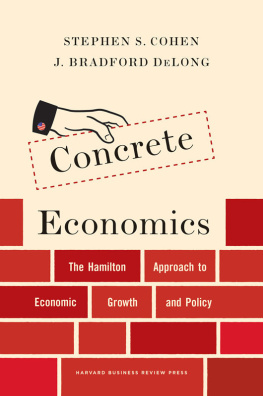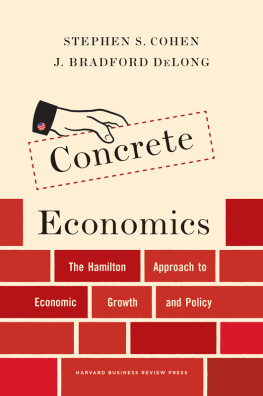Concrete
Economics

HBR Press Quantity Sales Discounts
Harvard Business Review Press titles are available at significant quantity discounts when purchased in bulk for client gifts, sales promotions, and premiums. Specialeditions, including books with corporate logos, customized covers, and letters from the company or CEO printed in the front matter, as well as excerpts of existing books, can also be created in large quantities for special needs.
For details and discount information for both print and ebook formats, contact
Copyright 2016 Stephen Cohen and Bradford DeLong
All rights reserved
No part of this publication may be reproduced, stored in or introduced into a retrieval system, or transmitted, in any form, or by any means (electronic, mechanical, photocopying, recording, or otherwise), without the prior permission of the publisher. Requests for permission should be directed to , or mailed to Permissions, Harvard Business School Publishing, 60 Harvard Way, Boston, Massachusetts 02163.
The web addresses referenced in this book were live and correct at the time of the books publication but may be subject to change.
Library of Congress Cataloging-in-Publication Data
Names: Cohen, Stephen S., author. | De Long, J. Bradford, author.
Title: Concrete economics : the Hamilton approach to economic growth and policy / Stephen S. Cohen, J. Bradford DeLong.
Description: Boston : Harvard Business Review Press, 2016.
Identifiers: LCCN 2015043604 (print) | LCCN 2015049475 (ebook) | ISBN 9781422189818 (hardback) | ISBN 9781422189825 ()
Subjects: LCSH: United StatesEconomic policy. | Economic developmentUnited StatesHistory. | historyUnited StatesHistory. | BISAC: BUSINESS & ECONOMICS / Government & Business. | BUSINESS & ECONOMICS / Economics / General. | BUSINESS & ECONOMICS / Economic History.
Classification: LCC HC106.84 .C64 2016 (print) | LCC HC106.84 (ebook) | DDC 330.973dc23
LC record available at http://lccn.loc.gov/2015043604
For Julia and Eleanor
and
For Ann Marie, Michael, and Gianna
Contents
Preface
This book does not provide any important new facts. It sets out no new economic theories. It offers no analyses of new data sets. It uses no new statistical tools. If, accidentally, we do any of these, we have in some sense failed. And we will definitely have failed if this book is not accessible, readable, and enjoyable.
Everything this book presents isor at least waswell and widely known.
Recently, however, much seems to have been forgotten. So this book tries to do something important. It tries to remind us, in simple, concrete terms, of how the American economy, again and again, was reshaped and reinvigorated by a loveless interplay of government making broad economic policy and entrepreneurs seeking business opportunities.
This book, therefore, is about government and entrepreneurship. But it will not rehash the sturdy and well-known arguments that, to thrive, an entrepreneurial economy needs an environment characterized by a broad range of freedoms, protections, and incentives. Consider that argument axiomatic.
We are here to talk about the other important interplay of government and entrepreneurship. And it is very important.
Repeatedly, government in the United States opened a new economic space, doing what was needed to enable and encourage entrepreneurs to rush into that space, innovate, expand it and, over time, reshape the economy. Each time, and there were many, this was done pragmatically. The choice of economic space seemed obvious, and the meanswhile powerful interests usually had a leg upwas never the bright idea of some smart economist or distinguished committee; it was never guided by ideology, whether pure or in the guise of theory. And each time in Americas long economic historyexcept for the most recent one, which was based on ideology rather than pragmatismthe results have been very positive indeed.
From a global, birds-eye view, three centuries ago the worlds high civilizations were roughly equal in prosperity. Today the North Atlantic nations (including a few honorary North Atlantic countries like Japan and Australia) are richer by a factor of at least five. And the overwhelming bulk of that divergence is due to economic policy. The postWorld War II reinvigoration of Western Europe, the post-1975 rise of China, and the post-1913 relative economic decline of Argentina were, no serious thinkers dispute, predominantly driven by good and bad economic policy.
That policy matters most is clear from this global record. In successful economies, economic policy has focused on what works for people who are trying to increase productivity on the ground, not on the voices heard by madmen in authority or the doctrines of academic scribblers. That is the lesson we draw from our reading of economic history. Getting economic policy rightand getting the political economy right, so that the country can get its economic policy rightis and has been of overwhelming importance in generating prosperity. But a global, birds-eye view cannot provide us with enough detail to understand how, exactly, or what getting the economic policy right really means.
For that, we have to focus.
And so this book will focus on the United States, which is, fortunately for us, the place where economic policy has been, without a doubt, the most successful over the past couple of centuries.
When we look at the United States, we find not one design of economic policy, but rather sequential redesigns as the economic environment and the policies that offer the best chance of successful medium-term growth shift.
Beginning with Alexander Hamilton, the architect of the first and most important redesign, and moving on to Abraham Lincoln and the Republican ascendancy, to Teddy Roosevelt, Franklin Roosevelt, and Dwight Eisenhower, the US government is always there, taking the lead, opening new economic spaces. It is doing so consciously. And it is doing so pragmaticallynot ideologically. And it is doing so very successfully, at least until recently.
We have forgotten our history. This book seeks to remind us of our history.
Introduction
In successful economies, economic policy has been pragmatic, not ideological. It has been concrete, not abstract.
And so it has been in the United States. From its very beginning, the United States again and again enacted policies to shift its economy onto a new growth directiontoward a new economic space of opportunity. These redirections have been big. And they have been collective choices. They have not been the emergent outcomes of innumerable individual choices aimed at achieving other goals. They have not been the unguided results of mindless evolution. They have been intelligent designs.
And they have been implemented by government, backed and pushed by powerful and often broad-based political forces, held together by a common vision of how the economy ought to change. They have then been brought to life, expanded, and transformed in extraordinary ways by entrepreneurial activity and energy. The new direction has always been selected pragmatically, not ideologically, and presented concretely. You could see it in advanceas in, This is the kind of thing we are going to get.
Until the latest redesign, beginning in the 1980s.
Yes, there was an invisible hand, and enormous entrepreneurial innovation and energy. But the invisible hand was repeatedly lifted at the elbow by government, and re-placed in a new position from where it could go on to perform its magic. Government signaled the direction, cleared the way, set up the path, andwhen neededprovided the means. And then the entrepreneurs rushed in, innovated, took risks, profited, and expanded that new direction in ways that had not and could not have been foreseen. The new or newly transformed sectors grew, often quickly. In growing they pulled other new activities into existence around them. The effect was to reinvigorate, redirect, and reshape the economy.
Next page










